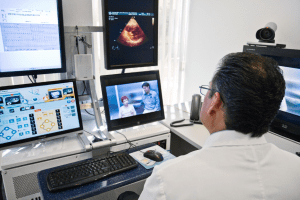Audrey Herrald ’23, Neuroscience, Summer 2020
Figure 1: Remote healthcare services offer neurology patients the ability to receive care even when there is no on-site neurologist available.2
For many pediatric neurologists, a patient visit might run something like this: a brief introduction, some friendly chatter, a review of the patient’s history, and an examination of any symptoms and test results. Based on what is seen during the visit, the physician will issue diagnoses, directives for additional testing, and/or treatment recommendations.
Usually, this type of visit could occur at a neurologist’s place of practice. However, the COVID-19 pandemic has necessitated changes to healthcare delivery, and analysts now predict that virtual healthcare visits will soar to more than 1 billion this year—a tremendous jump from their original expectation of 36 million visits for all of 2020.3
Now, nearly six months since the first reported case of COVID-19, the results of studies investigating new telemedicine systems are becoming available. The sudden paradigm shift in care delivery has ushered in countless questions. Among the most pressing: Are patients satisfied with video-call “visits”? How often do technical difficulties arise? Is remote treatment sufficient, or do calls tend to end with referrals for in-person care?1
A recent review of 2,589 telemedicine encounters in the Division of Neurology at the Children’s Hospital of Philadelphia addressed many of these questions.1 The researchers compared 14,780 in-person encounters and 2,589 telehealth encounters, noting patient demographics and diagnoses. The team also analyzed questionnaire responses addressing provider experience, follow-up plans, technical quality, need for in-person assessment, and parent/caregiver satisfaction.
Remarkably, clinicians found telemedicine “satisfactory” in 93 percent of encounters, even though 40 percent of clinicians reported technical challenges. These data suggest that the majority of technical challenges (poor audio, most prominently), are far from debilitating; on the contrary, adequate care delivery via telemedicine videocall seems well within reach. As for the patients, 89 percent received treatment plans that included telemedicine, and nearly all (86 percent of the total cohort) indicated an interest in telemedicine for future care.1
These results are particularly noteworthy because they begin to fill a sizeable gap in telemedicine research; even as assessments of telemedicine in general practice continue to emerge, studies of telemedicine for specialized treatment (e.g. pediatric neurology) remain scarce. The research team emphasizes that their results offer some of the first targeted evidence for the feasibility and effectiveness of telemedicine in pediatric neurology.1
Looking forward, the team plans to focus their attention on the 5 percent of cases that neurologists flagged as warranting an in-person assessment. Cases related to epilepsy made up most of the in-person referrals, followed by neuromuscular disorders and sensory disturbances.1 The researchers suggest that remote monitoring technologies—seizure detection devices, long-term remote EEG monitoring, and electronic pillboxes among them—could further reduce the necessity of in-person assessments, serving as the critical next steps for neurological telemedicine.
Bibliography
[1] Rametta, S. C., Fridinger, S. E., Gonzalez, A. K., Xian, J., Galer, P. D., Kaufman, M., Prelack, M. S., Sharif, U., Fitzgerald, M. P., Melamed, S. E., Malcolm, M. P., Kessler, S. K., Stephenson, D. J., Banwell, B. L., Abend, N. S., & Helbig, I. (2020). Analyzing 2,589 child neurology telehealth encounters necessitated by the COVID-19 pandemic. Neurology, 10.1212/WNL.0000000000010010. https://doi.org/10.1212/WNL.0000000000010010
[2] Press, I. F. (2011). English: Dr. Juan Manuel Romero, a cardiologist at a hospital in Ciudad Obregon in Sonora, Mexico, engages in a pre-op consultation with Alma Guadalupe Xoletxilva and her doctor, Edgar Cuevas, who are 400 miles away in La Paz, Baja California. https://www.flickr.com/photos/intelfreepress/6948764580/sizes/o/in/photostream/.https://commons.wikimedia.org/wiki/File:Telemedicine_Consult.jpg
[3] US Virtual Care Visits To Soar To More Than 1 Billion · Forrester. (n.d.). Forrester. Retrieved July 3, 2020, from https://go.forrester.com/press-newsroom/us-virtual-care-visits-to-soar-to-more-than-1-billion/
